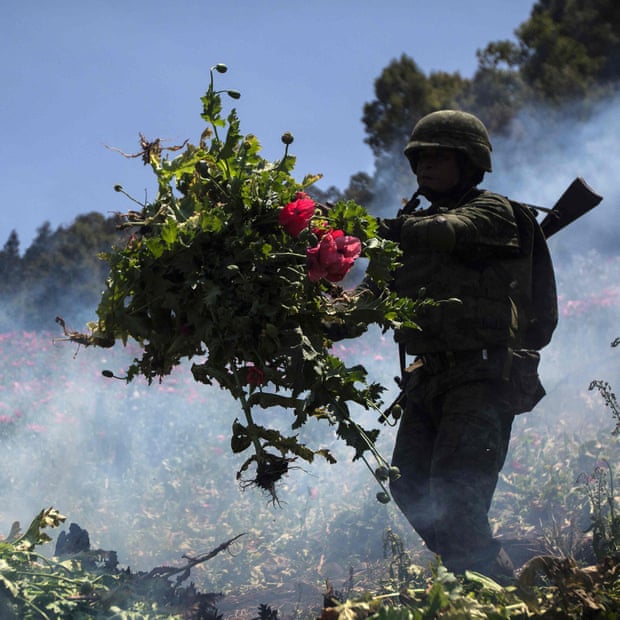Here in Mexico’s most murderous municipality the bodies appear with nauseating frequency – or at least, parts of them do.
Some are stashed in bin bags or hammocks; others in blood-soaked rucksacks. Some are dumped in bike lanes or canals; others left on street corners or football pitches – severed, shredded and stomach-churning symbols of the country’s failing war on drugs.
“Sometimes we don’t even know who they are,” admitted Arturo Bautista, the silver-haired administrator of Tecomán’s cemetery and the final custodian of the victims of this Pacific beach town’s relentless killing machine.
In few places can the ferocity and futility of Mexico’s war on drugs be felt more than Tecomán, a once tranquil coastal community. Last year its murder rate of a reported 172.51 deaths per 100,000 inhabitants resembled that of a war zone.
Experts blame Mexico’s militarized assault on the drug cartels – launched by former president Felipe Calderón in 2006 – for fragmenting them into smaller, warring factions and sparking a turf war that has turned Tecomán and neighboring municipalities along its strategic west coast into some of the country’s deadliest.
Now, after an estimated 200,000 deaths, Mexico’s incoming president has pledged to overhaul that “failed strategy”.
“You cannot fight violence with violence,” Andrés Manuel López Obrador vowed this week in Ciudad Juárez, one of Mexico’s most notoriously violent cities, at the start of a series of nationwide debates on security policy. “You cannot combat evil with evil.”
Such pledges are music to the ears of voters in Tecomán and three nearby municipalities – Armería, Ixtlahuacán and Manzanillo – all of which elected mayors from Amlo’s party, Morena, in July.
“It was a tsunami, an Andrés Manuel tsunami,” celebrated Marco Antonio Quintana, a local teacher and activist who believes many backed Amlo’s party hoping it could halt the bloodletting.
Elías Lozano, Tecomán’s mayor-elect, said he was determined to revive an agricultural town once famed for its limes. “People are crying out for security,” the 56-year-old businessman said. “Tecomenses are decent people and we deserve to live differently.”
López Obrador, or Amlo as most call him, only takes power in December and the precise details of his approach to public security remain unclear. But early indications suggest he will rely far less on militarised repression and focus more on the social roots of crime.
Quick GuideMexico's war on drugs
Show

Why did Mexico launch its war on drugs?
On 10 December 2006, Felipe Calderón launched Mexico’s war on drugs by sending 6,500 troops into his home state of Michoacán, where rival cartels were engaged in tit-for-tat massacres.
Calderón declared war eight days after taking power – a move widely seen as an attempt to boost his own legitimacy after a bitterly contested election victory. Within two months, around 20,000 troops were involved in operations.
What has the war cost so far?
The US has donated at least $1.5bn through the Merida Initiative since 2008, while Mexico spent at least $54bn on security and defence between 2007 and 2016. Critics say that this influx of cash has helped create an opaque security industry open to corruption.
But the biggest costs have been human: since 2007, over 250,000 people have been murdered, more than 40,000 reported as disappeared and 26,000 unidentified bodies in morgues across the country. Human rights groups have also detailed a vast rise in human rights abuses including torture, extrajudicial killings and forced disappearances by state security forces.
Peña Nieto claimed to have killed or detained 110 of 122 of his government's most wanted narcos. But his biggest victory – and most embarrassing blunder – was the recapture, escape, another recapture and extradition of Joaquín “El Chapo” Guzmán, leader of the Sinaloa cartel.
Mexico’s decade-long war on drugs would never have been possible without the injection of American cash and military cooperation under the Merida Initiative. The funds have continued to flow despite indisputable evidence of human rights violations.
Under new president Andrés Manuel López Obrador, murder rates are up and a new security force, the Civil Guard, is being deployed onto the streets despite campaign promises to end the drug war.
What has been achieved?
Improved collaboration between the US and Mexico has resulted in numerous high-profile arrests and drug busts. Officials say 25 of the 37 drug traffickers on Calderón’s most-wanted list have been jailed, extradited to the US or killed, although not all of these actions have been independently corroborated.
The biggest victory – and most embarrassing blunder – under Peña Nieto’s leadership was the recapture, escape and another recapture of Joaquín “El Chapo” Guzmán, leader of the Sinaloa cartel.
While the crackdown and capture of kingpins has won praise from the media and US, it has done little to reduce the violence.
Amlo’s “pacification” roadmap includes:
- Holding nationwide “listening forums” where victims of violence, religious leaders and academics will be consulted on security policy. At the first such audience on Tuesday, Amlo said no stone would be left unturned in his bid “to pacify our dear Mexico”. “There must be no taboos, no self-censorship ... Everything the people of Mexico agree on will be carried out.”
- Considering the decriminalisation of marijuana and a limited amnesty for non-violent criminals. “I say: ‘Forgive but don’t forget,’” Amlo said.
- Creating truth commissions to investigate the worst episodes of violence.
- Taking personal responsibility for security policy and hosting daily 6am security meetings.
Indira Vizcaíno, Amlo’s point-person in Colima state, where Tecomán is located, said security policy would no longer “just be a matter of fighting fire with fire”. “Crime rates aren’t going up because the people feel like being bad. Crime rates are going up because people need to eat.”
“This doesn’t doesn’t mean he won’t also have a strategy to tackle organised crime … Of course he will. But his key objective is to deal with the causes,” she said, during an interview at a restaurant in Colima’s capital that was the scene of a 2015 assassination attempt on its ex-governor.

Considering the decriminalisation of “some drugs” was definitely on Amlo’s agenda, Vizcaíno added.
Benjamin Lessing, author of Making Peace in Drug Wars, said he was encouraged by Amlo’s willingness to consider taboo policies such as decriminalisation and amnesty, even if the latter word was needlessly inflammatory.
One of the biggest problems with debating drug policy was that too many options were rejected because of prejudice, he said: “Instead we get caught up in a kind of hysteria – that we have to fight to the death and that all the traffickers have to be eliminated.”
Instead, Lessing said he believed Amlo should adopt a “violence minimisation” strategy designed to slash Mexico’s homicide rate by targeting cartels that insisted in perpetrating acts of deadly violence such as those ravaging Tecomán.
“When there is … a spiral of homicidal violence, the most important thing is to make it clear – especially to organised crime – that it doesn’t pay to be violent. And the way you send this message is you punish them more for being violent, [and] you pull back on investigating non-violent criminal activity.
He went on: “Hold back on the drug war part [and] say: ‘Look, our priority right now is to bring down the homicide rate and that requires that we are not going to be patrolling the frontier as much, or patrolling the highways where the drugs are passing as much.”
There was “no one silver bullet to reduce homicide” but such a policy might at least help slow the killing.
That is an urgent task in Tecomán, where the butchery shows no sign of slowing.
Last week, after a brief and unusual lull in the bloodletting over the election period, a decapitated corpse was dumped on a bridge outside town. Days earlier a clandestine cemetery containing an unknown number of corpses was found.
Lozano admitted pacifying such a place would be hard. To illustrate his point he told the story of a local entrepreneur who had tightened security on their ranch after discovering widespread crystal meth use among workers.
Soon after, a letter arrived warning that the company’s directors of would start to die if the crackdown continued. “They stopped,” the mayor elect said.

Lozano, who admitted he needed to be “very careful” discussing such “a delicate topic,” emphasised it was not a mayor’s job to combat the cartels. “But it’s very difficult to see what is happening and not be able to do anything,” he added, hinting one solution might be creating community militias as seen in the neighbouring state of Michoacán.
Asked how Tecomán had fallen prey to such carnage, Lozano blamed “the lack of honest politicians.
“That’s the root of it all. Politicians had the choice of deciding between staying on the sidelines or getting involved – and many decided to get involved because there were economic benefits.”
Vizcaíno said the scale of the tragedy hit her in February when she visited Tecomán’s cemetery for the burial of a local politician who was gunned down by assassins. All around she saw almond-coloured mounds of earth, some large, others tiny, hastily dug graves for the adult and infant victims of a seemingly unstoppable slaughter.
“They are killing children,” Vizcaíno gasped, her voice trailing off. “It just felt like Tecomán had become a town without law.”
